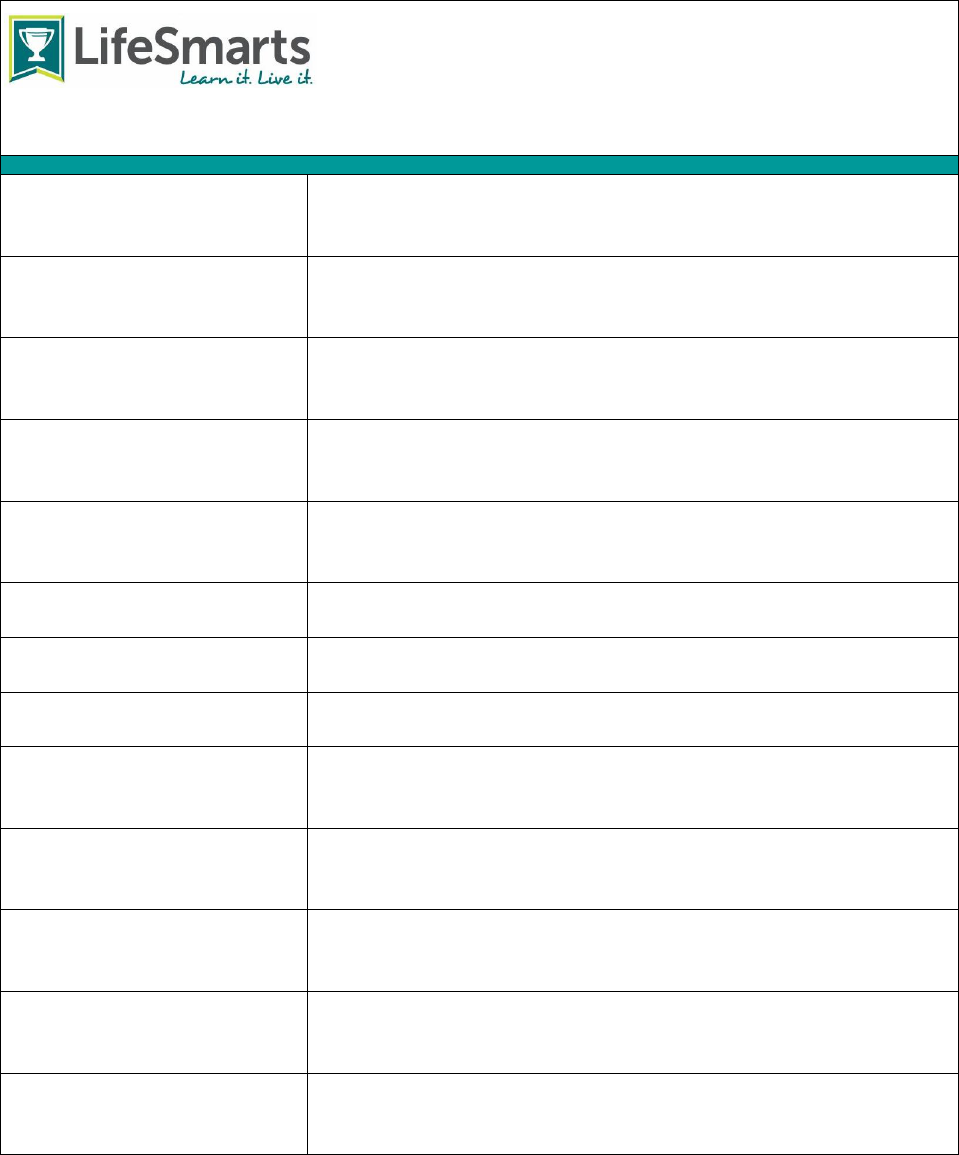ConsumerMan Video for LifeSmarts 10: BUYING A CAR
Lesson Plan
Overview
Whether new or used, buying a vehicle is probably the largest purchase a teenage will make. While those
in the business sell cars every day, the average consumer has little experience buying a vehicle. Knowing
some basic strategies can make the process less stressful.
Lesson Objective
Review basic information related to the process of purchasing a new or used vehicle.
Time
1 class period
Background
The purchase of a vehicle can be divided into several separate transactions:
1. Select the appropriate vehicle.
2. Negotiate the purchase price.
3. Determine the value of the trade-in.
4. Acquire the most advantageous financing.
The well-informed consumer is aware that there are hundreds of cars and dealers to choose from. So it is
wise to consider each part of the transaction carefully, going step-by-step. Negotiating a “good deal”
takes patience and an understanding of the process.
Materials
Lesson Vocabulary List Prompts
Lesson Vocabulary List
Video-Buying a Car
Activity Key-Just the Facts – Buying a Car
Video Activity- Just the Facts – Buying a Car
Resource: Federal Trade Commission Consumer Information-Buying a Used Car:
http://www.consumer.ftc.gov/articles/0055-buying-used-car
Procedures
1. Distribute Vocabulary List Worksheet
2. Assign students to define only the vocabulary they are confident they understand.
3. Clarify and define vocabulary with the large group.
4. Distribute the Just the Facts – Buying a Car to each student. Review the activity instructions and
allow time for students to complete their work.
5. View the video Buying a Car
6. Review and discuss answers to Just the Facts – Buying a Car.
Discussion Questions and Statements
1. React: Because of the serious impact on the environment, teenagers do not need cars.
2. React: Teenagers who are pulled over for texting or talking on cell phones should have their licenses
suspended.
3. Parents can now purchase “safe driver” devices that monitor the driver’s speed and track vehicle
location via GPS. What are the advantages and disadvantages of this technology?
4. Owning and driving a vehicle is a luxury most teenagers in the world never experience. Explain how
American teens view this privilege.

ConsumerMan Video for LifeSmarts 10:
Buying a Car Vocabulary List Prompts
Name:
base price
Cost of a vehicle with standard equipment; no options or upgrades
book value
Estimated market or trade-in worth of a used vehicle as published in a
guide by businesses such as Kelley Blue Book, Edmunds or NADA
extended warranty
Service contract that provides for no cost or low cost vehicle repair,
after the factory or dealer warranty expires
FTC Used Car Rule
The rule that requires all used car dealers to place a "Buyers Guide" in
a conspicuous place in each used vehicle they offer for sale
factory warranty
Promise by the vehicle manufacturer to repair or replace defective
components for a specific period of time
invoice price
Approximate price the dealership pays to the manufacturer for the
vehicle
lemon laws
These state laws protect buyers when vehicles have serious defects
Monroney sticker
A window sticker, required by law to be placed on every new vehicle,
includes information such as MSRP and fuel economy
NHTSA
National Highway Traffic Safety Administration, the federal agency
dedicated to achieving the highest standards of excellence in motor
vehicle and highway safety
recall
When a safety defect is discovered, the manufacturer is required to
remedy the problem at no charge to the owner
registration
Legally recording ownership of a vehicle with a government agency
for tax and licensing purposes; the registration certificate is carried in
the vehicle
title
Document that shows legal ownership of a vehicle
VIN
Vehicle Identification Number, a unique code used by the automobile
industry to identify and track each vehicle manufactured

ConsumerMan Video for LifeSmarts 10:
Buying a Car Vocabulary List
Name:
base price
book value
extended warranty
FTC Used Car Rule
factory warranty
invoice price
lemon laws
Monroney sticker
NHTSA
recall
registration
title
VIN

ConsumerMan Video for LifeSmarts 10:
Just the Facts-Buying a Car Activity Key
Name:
DIRECTIONS: The statements below are either true or false. Read the statement and decide whether it is
true or false. Circle true or false to indicate your choice. Correct the false statements by adding
information to the statement.
For example, There are twenty questions on this worksheet is a false statement. Correct this statement
by clarifying—There are fifteen questions on this worksheet, NOT by adding a negative such as, There are
not twenty questions on this worksheet.
1
When buying a vehicle, one of the most important parts of getting a “good deal” is
making sure the monthly payments are affordable.
Car buying experts advise that the “good deal” is based on negotiating the total
vehicle price. The monthly payment can be determined and adjusted after the price
is agreed upon.
True
False
2
When buying a vehicle, begin your negotiations with the invoice price.
The invoice price is close to the price the dealer paid the manufacturer. The dealer
may receive additional incentive from the manufacturer, but buying a vehicle for
close to invoice price is good negotiation.
True
False
3
Once you have decided on the vehicle you want to purchase and have negotiated
the price, go to the bank or credit union to discuss financing.
Before you enter a dealership, discuss financing with the financial institution. Ask
about the type of loan, how much interest you’ll pay, and the terms of the contract.
Know what price point you can afford and the total cost if you finance through your
financial institution.
True
False
4
Focusing only on the monthly payment could result in paying too much for a vehicle.
The monthly payment is not a true indicator of the cost of the car and never the
price to negotiate.
True
False
5
When a trade-in is part of a vehicle purchase, the dealer will offer the best price for
the trade-in because they want to make a sale.
Consumers should always check “book value” for their trade-in before they
negotiate. There are a number of website that offer calculators to help estimate a
vehicle’s worth; examples include Edmunds, Nada Guides and Kelley Blue Book.
True
False
6
The invoice price tells exactly what the dealer paid for the vehicle.
Car manufacturers create incentives and purchase programs for car dealers. These
incentives can change the dealer’s price, but the invoice gives the buyer a good
indication of the approximate cost.
True
False
7
The consumer does not buy cars every day, but they do have the most important
negotiating “tool.”
As expert Jack Gillis says, the consumer’s most effective bargaining tool is the 180-
degree turn and walk away. If the buyer feels uncomfortable or feels they have been
treated with disrespect, they can leave the dealership.
True
False

8
Purchasing a used car can save the consumer an average of 25% in overall ownership
and operating costs.
The savings are even larger. A used car can save the consumer 50% of those costs.
True
False
9
One should investigate insurance costs before making a final decision to purchase a
vehicle.
Experts recommend getting estimates from three different insurance companies. For
teens, insurance is a significant expense.
True
False
10
One of the first steps in the vehicle buying process is to discuss the amount of your
monthly payments with the salesperson.
Discuss the monthly payment schedule only after you have negotiated the final price
of the vehicle. Monthly payments do not reflect the total purchase price.
True
False
11
When buying a used vehicle, it saves money for the consumer to request that the
dealership give the car a thorough inspection before the sale is complete.
Before completing the sale it is a good idea to have any vehicle inspected, but use an
independent source to get a non-biased assessment of the vehicle.
True
False
12
The largest cost factor when owning a new vehicle is depreciation.
Typically, the most expensive cost of car ownership is the first year of depreciation.
While the average is a 20% loss of value, some vehicles lose up to 40%.
True
False
13
The Federal 3-Day Cooling Off Rule applies to new, not used vehicles.
The 3-Day Cooling Off Rule does not apply to any vehicle purchase; it is primarily for
items you purchase in the home.
True
False
14
Invoice price and base price are identical.
The invoice price is the manufacturer’s price to the dealer. The base price is the price
of a vehicle with standard equipment, no options or upgrades.
True
False
15
Lemon law is a mandated federal standard that outlines a consumer’s rights when a
vehicle has a unique problem that does respond to repair.
Lemon laws are determined by federal legislation, under the Magnuson-Moss Act,
and also by state statutes.
True
False

ConsumerMan Video for LifeSmarts 10:
Just the Facts-Buying a Car Activity
Name:
DIRECTIONS: The statements below are either true or false. Read the statement and decide whether it is
true or false. Circle true or false to indicate your choice. Correct the false statements by adding
information to the statement.
For example, There are twenty questions on this worksheet is a false statement. Correct this statement
by clarifying—There are fifteen questions on this worksheet, NOT by adding a negative such as, There are
not twenty questions on this worksheet.
1
When buying a vehicle, one of the most important parts of getting a “good deal” is
making sure the monthly payments are affordable.
True
False
2
When buying a vehicle, begin negotiations with the invoice price.
True
False
3
Once you have decided on the vehicle you want to purchase and have negotiated
the price, go to the bank or credit union to discuss financing.
True
False
4
Focusing only on the monthly payment could result in paying too much for a vehicle.
True
False
5
When a trade-in is part of a vehicle purchase, the dealer will offer the best price for
the trade-in because they want to make a sale.
True
False
6
The invoice price tells exactly what the dealer paid for the vehicle.
True
False
7
The consumer does not buy cars every day, but they do have the most important
negotiating “tool.”
True
False

8
Purchasing a used car can save the consumer an average of 25% in overall ownership
and operating costs.
True
False
9
One should investigate insurance costs before making a final decision to purchase a
vehicle.
True
False
10
One of the first steps in the vehicle buying process is to discuss the amount of your
monthly payments with the salesperson.
True
False
11
When buying a used vehicle, it saves money for the consumer to request that the
dealership give the car a thorough inspection before the sale is complete.
True
False
12
The largest cost factor when owning a new vehicle is depreciation.
True
False
13
The Federal 3-Day Cooling Off Rule applies to new, not used vehicles.
True
False
14
Invoice price and base price are identical.
True
False
15
Lemon law is a mandated federal standard that outlines a consumer’s rights when a
vehicle has a unique problem that does respond to repair.
True
False
